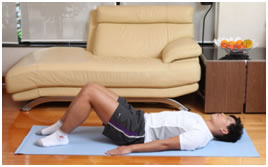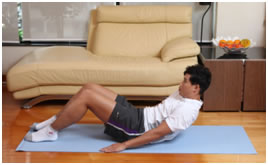Common Misconceptions
- Resistance exercises (such as fitness training in the gym) will cause the muscles to grow. Won't this affect ladies' slim figures?
- Once you stop resistance training, won't the muscle gained turn into fat?
- Shouldn't a lot of sweat be produced for exercise to be effective?
- Doesn't exercise on an empty stomach help burn fat and promote weight loss?
- Running and cycling will lead to thicker legs, so shouldn't ladies refrain from doing these exercises?
- If you eat immediately after exercise, won't it cause fat?
- Can just doing sit-ups be effective in reducing abdominal fat?
- Should pregnant women refrain from exercise?
Question 1:
Resistance exercises (such as fitness training in the gym) will cause the muscles to grow. Won't this affect ladies' slim figures?The truth: Although resistance exercises are aimed at increasing muscle mass and muscular endurance, muscle growth requires the male hormone (testosterone) for facilitation. Because the level of testosterone in a male's body is 20 to 30 times the level in a female's body, the training effect on men is much more obvious than it is on women. Therefore the ladies should not be concerned that muscle training will build up an unsightly muscle mass.
Question 2:
Once you stop resistance training, won't the muscle gained turn into fat?The truth: This concept is not correct. Muscle and fat are two completely different body tissues. With resistance training, the body's muscle mass and strength will increase accordingly. This is a normal physiological response to external stimulation. During the period after you have halted resistance training, your physiological response will gradually diminish and muscle atrophy will appear in place of the muscle mass previously built up, but it will not become fat. The real cause of the accumulation of fat is a combination of a lack of exercise, which slows the overall body metabolism, and a high calorie diet.
Question 3:
Shouldn't a lot of sweat be produced for exercise to be effective?The truth: Sweat is produced in a physiological response to the need to lower the body's temperature, and is not directly related to the effects of exercise. The amount of sweat produced during exercise depends on several factors, including exercise intensity, duration, environmental temperature and relative humidity. In addition, there is a gender difference, with men generally sweating more than women. Therefore, we cannot measure the effect of exercise by the amount of sweat produced.
Question 4:
Doesn't exercise on an empty stomach help burn fat and promote weight loss?The truth: The amount of fat that can be burned off is determined by the duration, intensity and type of exercise. Among the three types of exercise, aerobic exercise is the best for reducing body fat. Because the body first utilises carbohydrates as a fuel when you start an exercise with moderate intensity. After the exercise is performed for 10 to 20 minutes, the proportion of fat burned as a fuel increases progressively with time. Therefore, you should set a duration of at least 10 minutes of exercise as your target. In addition, it is best to eat a small amount of carbohydrate-based foods before exercising as it will make it easier for you to exercise longer, and burn much more fat as a result.
Question 5:
Running and cycling will lead to thicker legs, so shouldn't ladies refrain from doing these exercises?The truth: There is no scientific evidence to support this view. There are two kinds of body muscles: fast-twitch muscles (commonly known as white muscles) and slow-twitch muscles (commonly known as red muscles). The function of red muscles is to sustain lower intensity exercise (such as long-distance running, dancing, etc.) for a longer time. Even after training, these muscles will not significantly increase in size. Therefore, quite a number of endurance performance athletes, such as marathon runners, actually sport rather slim figures and legs. By contrast, white muscle is only good for short duration and explosive exercise. White muscle mass can be significantly built up through appropriate exercises. The typical examples of athletes who depend on white muscles are those who take part in sprints and in track and field throwing events. The upshot is, as long as you do the appropriate exercises at the required intensity level, you will achieve benefits without thickening your muscles. From the perspective of health, there are benefits to the enhancement of cardiovascular fitness while also maintaining a healthy weight.
Question 6:
If you eat immediately after exercise, won't it cause fat?The truth: This is not entirely correct. There is no scientific evidence that eating immediately after exercise will cause fat. On the contrary, consumption of mainly carbohydrate food together with adequate proteins shortly after exercising (about 30 minutes) can serve to restore body energy and repair muscle tissues, thus helping to meet one's needs for a daily workload and other physical activities. (Note: the digestive system needs a little time to recover after the exercise and this timing will vary person to person; therefore, if you encounter problems from eating right after exercise, you should wait a little while before eating in order to avoid indigestion.)
Question 7:
Can just doing sit-ups be effective in reducing abdominal fat?The truth: Doing sit-up exercises for reducing belly fat or training abdominal muscles is not effective at all. There are two reasons for this: Firstly, it is not an aerobic exercise, so it is less effective in promoting weight loss. Secondly, the movement is primarily related to the hip flexors rather than the abdominal muscles. The recommended exercise is abdominal crunch. (please see Figure 1). If you want to know how to do crunch exercises properly, please consult a professional fitness instructor. If you wish to learn more exercises for muscle strengthening, please visit the website of Exercise Prescription Project.
 a |
 b |
| Figure 1 The correct crunch exercise | |
Question 8:
Should pregnant women refrain from exercise?The truth: In general, exercise is good both for pregnant women and fetal health. It is definitely not a taboo. Regular exercise can reduce the risk of illness resulting from pregnancy, such as pregnancy-induced hypertension, gestational diabetes and musculoskeletal problems. On the other hand, pregnant women should avoid vigorous and high-impact sports such as racquet and ball games. Among the aerobic exercises, they may choose walking, back-supported stationary cycling and swimming and so on. Pregnant women can also do resistance training, but it should only be at low to moderate intensity (weight), preferably with a professional fitness trainer to supervise. However, it is worth noting that pregnant women who have led a sedentary life in the past, or who have existing health problems, should seek a doctor's medical advice and consent if they want to participate in an exercise program. If consent is granted, they should do so in a progressive manner.
 Top
Top



